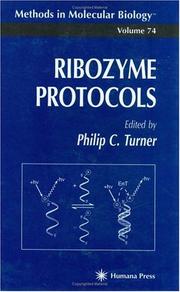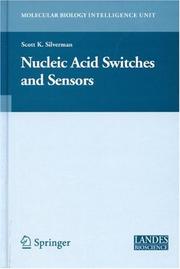| Listing 1 - 3 of 3 |
Sort by
|

ISBN: 0896033899 9786610837397 128083739X 159259560X Year: 1997 Publisher: Totowa, NJ : Humana Press : Imprint: Humana,
Abstract | Keywords | Export | Availability | Bookmark
 Loading...
Loading...Choose an application
- Reference Manager
- EndNote
- RefWorks (Direct export to RefWorks)
Ribozyme Protocols brings together a broad spectrum of essential and easily reproducible techniques currently used by leading researchers to manipulate RNA molecules and to inactivate gene expression in vivo. The methods collected here range from theoretical design to clinical application and include the synthesis and assay of ribozymes, as well as their use both in vitro and in vivo. Each method is presented by an expert with substantial hands-on experience and in far greater detail than is generally to be found in the research literature. Ribozyme Protocols will help all investigators perform meaningful and successful experiments using ribozymes in both clinical and basic research, as well as launch fresh application initiatives. It is certain to be found indispensable not only by those workers new to the field, but also by experienced researchers who wish to expand their range of expertise.
Catalytic RNA -- Laboratory manuals. --- Electronic books. -- local. --- Nucleic acids -- Laboratory manuals. --- Catalytic RNA --- Genetic Techniques --- RNA, Catalytic --- RNA, Untranslated --- Investigative Techniques --- Enzymes --- Analytical, Diagnostic and Therapeutic Techniques and Equipment --- Enzymes and Coenzymes --- RNA --- Chemicals and Drugs --- Nucleic Acids --- Nucleic Acids, Nucleotides, and Nucleosides --- Animal Biochemistry --- Human Anatomy & Physiology --- Health & Biological Sciences --- Laboratory manuals --- RNA, Catalytic. --- Genetic Techniques. --- Laboratory manuals. --- Catalytic rna --- Genetic techniques. --- Rna, catalytic. --- Nucleic acids --- Polynucleotides --- Biomolecules --- Ribonucleic acid enzymes --- Ribozymes --- RNA enzymes --- Non-coding RNA --- Nucleases --- Biochemistry. --- Biochemistry, general. --- Biological chemistry --- Chemical composition of organisms --- Organisms --- Physiological chemistry --- Biology --- Chemistry --- Medical sciences --- Composition
Book
ISBN: 1441911413 1461425735 9786612831577 1282831577 1441911421 Year: 2010 Publisher: New York : Springer Science,
Abstract | Keywords | Export | Availability | Bookmark
 Loading...
Loading...Choose an application
- Reference Manager
- EndNote
- RefWorks (Direct export to RefWorks)
Ribonuclease P (RNaseP), a ribonucleoprotein, is an essential tRNA processing enzyme found in all living organisms. Since its discovery almost 40 years ago, research on RNase P has led to the discovery of the catalytic properties of RNA, and of the only known, naturally occurring RNA enzymes, RNase P catalytic RNA. The description of the catalytic properties of RNA has provided fundamental insight into the RNA world and these catalytic properties are being harnessed as therapeutic and prevention strategies for acquired and inherited diseases. Ribonuclease P is the first book to provide a comprehensive collection covering all aspects of current research on RNase P. The topics include kinetic and structural analysis, mechanism of catalysis, and its regulation and biogenesis in prokaryotes, eukaryotes, and organelles. Furthermore, research progresses on developing RNase P as a potential drug target for antimicrobial development and as a gene-targeting tool for anti-infective and anticancer therapy are also included. This book should be of general interests to molecular biologists and biochemists in both the academic section and pharmaceutical industry.
Gene silencing. --- Ribonucleases. --- RNA. --- Small interfering RNA -- Therapeutic use. --- RNA --- Ribonucleases --- Ribonucleoproteins --- Endoribonucleases --- RNA, Catalytic --- Nucleic Acids --- Ribonuclease P --- Enzymes --- RNA-Binding Proteins --- Nucleic Acids, Nucleotides, and Nucleosides --- Nucleoproteins --- Carrier Proteins --- Chemicals and Drugs --- Enzymes and Coenzymes --- Esterases --- Proteins --- Hydrolases --- Amino Acids, Peptides, and Proteins --- Human Anatomy & Physiology --- Chemistry --- Biochemistry --- Animal Biochemistry --- Physical Sciences & Mathematics --- Health & Biological Sciences --- Proteins. --- Proteids --- RNases --- Life sciences. --- Proteomics. --- Life Sciences. --- Molecular biology --- Biosciences --- Sciences, Life --- Science --- Biomolecules --- Polypeptides --- Proteomics --- Nucleases

ISBN: 9780387472577 0387374914 9780387374918 9786613250568 0387472576 128325056X Year: 2006 Publisher: Georgetown, Tex. : New York, N.Y. : Landes Bioscience/Eurekah.com ; Springer Science+Business Media,
Abstract | Keywords | Export | Availability | Bookmark
 Loading...
Loading...Choose an application
- Reference Manager
- EndNote
- RefWorks (Direct export to RefWorks)
In this book, seven chapters describe studies aimed at understanding and exploiting the key features of such molecular RNA and DNA devices. In the first section of the book, four chapters are devoted to artificial nucleic acid switches and sensors. These chapters introduce the concept of allosteric ribozymes as molecular switches and sensors; describe nucleic acid enzymes that are switched by oligonucleotides and other nucleic acid enzymes that are switched by proteins; and illustrate how switching elements can be integrated ration-ally into fluorescently signaling molecular sensors made out of nucleic acids. In the second section of the book, three chapters show that nature has been as crafty a molecular-scale engineer as any modern scientist via evolution of natural nucleic acid switches and sensors. RNAs have been found whose activities are modulated either by proteins or by small-molecule metabolites, and both kinds of system are described. Finally, the notion of exploiting naturally occurring RNA switches for drug development is discussed.
Biomedicine. --- Human Genetics. --- Medical Microbiology. --- Medicine. --- Human genetics. --- Microbiology. --- Médecine --- Génétique humaine --- Microbiologie --- Biosensors. --- Catalytic RNA. --- RNA -- Biotechnology. --- Catalytic RNA --- Biosensors --- RNA --- Enzymes --- Nucleic Acids, Nucleotides, and Nucleosides --- RNA, Untranslated --- Genes, Regulator --- Molecular Probe Techniques --- Metabolic Phenomena --- RNA, Catalytic --- Biosensing Techniques --- Metabolism --- Genes, Switch --- Nucleic Acids --- Investigative Techniques --- Genes --- Chemicals and Drugs --- Enzymes and Coenzymes --- Phenomena and Processes --- Analytical, Diagnostic and Therapeutic Techniques and Equipment --- Genome Components --- Genome --- Genetic Structures --- Genetic Phenomena --- Human Anatomy & Physiology --- Biology --- Medicine --- Pathology --- Animal Biochemistry --- Genetics --- Health & Biological Sciences --- Biotechnology --- Biotechnology. --- Biodetectors --- Biological detectors --- Biological sensors --- Biomedical detectors --- Biomedical sensors --- Ribonucleic acid enzymes --- Ribozymes --- RNA enzymes --- Medical microbiology. --- Detectors --- Medical instruments and apparatus --- Physiological apparatus --- Non-coding RNA --- Nucleases
| Listing 1 - 3 of 3 |
Sort by
|

 Search
Search Feedback
Feedback About UniCat
About UniCat  Help
Help News
News